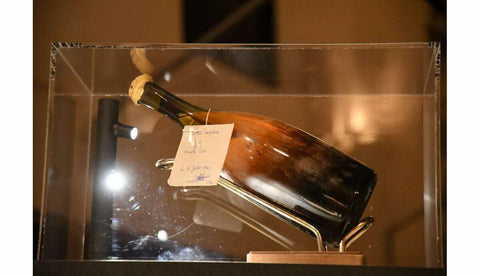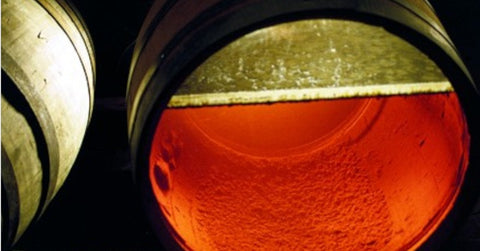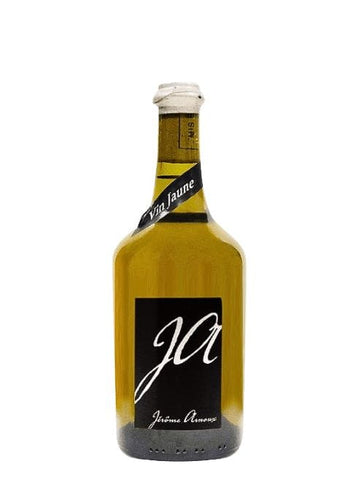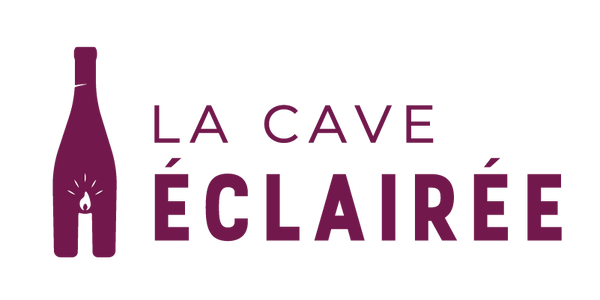Every first weekend of February, nearly 30 000 visitors converge on the Jura. What major event draws such crowds ? The Percée du vin jaune of course ! Celebrated each year in turn in one of the region's wine-producing villages, the ceremony celebrates the « mise en perce » (opening made to a barrel to draw the wine) after six years and three months of aging, which is the minimum time required to be able to sell the famous wine.
The ceremony is an opportunity for the public to taste yellow wines and Jura wines in numerous cellars where most of the producers set up for the occasion.
But how did we come to celebrate yellow wine ? What is its history? Where and how is it made ? What does it taste like ? You will find all the answers to these questions in this reading of less than 5 minutes.
History of Yellow Wine
The history of yellow wine begins with a legend : it tells of a winemaker who, having abandoned a barrel at the back of his cellar, was very pleasantly surprised, many years later, by the delicious flavor of the nectar obtained. Was it then by chance that yellow wine was born? While the story is delightful, it is probably too good to be true.
Unfortunately, to date, very few elements are accessible to confirm the precise origin of this wine. Indeed, while the first written record documenting vin jaune dates back only to 1822, we know that its existence is older because the oldest bottle of vin jaune found dates back to 1774. Some assumptions even trace its origins back to the 13th century !
Finally, the famous « Percée du vin jaune » was only created in 1996 by the winemaker Bernard Badoz to honor the subtlety and complexity of this precious golden nectar.If its initial intention was to create a true evening of discovery and tasting, it must be admitted that the event has since lost its luster and most often turns into a drinking spree (just like the festivities organized for Beaujolais Nouveau).
 Oldest bottle of Vin Jaune auctioned for €103,700 in 2018
Oldest bottle of Vin Jaune auctioned for €103,700 in 2018
Production & vinification
While the history of this wine remains generally quite mysterious, it is nevertheless easier to understand its production and vinification.First of all, the yellow wine comes (as you must have understood) from the Jura, a small wine region extending over 80 kilometers, and can be produced within 4 AOCs: Côtes du Jura, Étoile, Arbois as well as Château-Chalon, whose 50 hectares are dedicated solely to its production.
Furthermore, it is a wine produced from a single and unique local grape variety : the savagnin. While this grape can certainly be vinified in a "classic" manner to make a fruity and saline wine, a completely different profile of aromas will emerge when it is made into yellow wine.
To bear the designation "yellow wine," the savagnin must be aged in oak barrels for a minimum of 6 years and three months without topping up.Topping up is a method that involves filling a barrel gradually as the wine inside evaporates (the famous " angel's share ") with the same wine of similar quality. This process helps protect the wine being aged from oxidation (as the wine is in contact with more oxygen in the barrel if it is not completely filled).
Here, thanks to this non-topping up, a yeast film will form on the surface of the liquid in the barrel, thus protecting the wine from excess oxygen. It is this atypical and long barrel aging that will give the wine its famous " yellow " taste with complex and unique aromas.
Once the winemaking process is complete, our nectar will be bottled in a specific format : the clavelin, a beautiful bottle with an "old school" appearance of 62 cl. Why this volume? Simply because after evaporation during this long aging process (see "angel's share"), there would theoretically remain 62 cl of wine for each liter initially vinified.
 Yeast film developing in an unfilled barrel
Yeast film developing in an unfilled barrel
A wine with a unique taste
Beware of the first sip of vin jaune! It is a surprising and divisive nectar that enthusiasts love but can be very disconcerting for newcomers.Without residual sugar (dry), powerful aromas emanate on the nose and are confirmed on the palate: it is a heady and intense beverage whose usual markers are green apple, nutmeg, cinnamon, but especially dried fruits (walnut, almond) and curry. It is also preferable to proceed with an early opening or decanting to fully enjoy a bottle. Additionally, be careful not to consume the vin jaune too cold! The ideal serving temperature is between 14° and 16°C (like a light red). Sufficient on its own for tasting, vin jaune is, in my opinion, particularly interesting at the table where it will make a magnificent partner.Combining very well with spicy Asian dishes, nothing will enhance it better than the classic pairings with a 12-month aged Comté cheese or with a chicken with morels : sublime !
To remember
Vin jaune is a white wine made from the Savagnin grape variety, aged for a minimum of 6 years and 3 months in barrels under a layer of yeast that gives it its full aromatic complexity (green apple, walnut, curry, etc.). It is bottled in a 62 cl bottle called a « clavelin ». With great intensity, it is a beverage of incredible aging potential capable of improving in the cellar for several decades (or even several centuries).
You understand, you must taste this unique wine at least once in your life ! To do so,
Cheers !








4 comments
Vin de Jura, long en bouche, un élixir pour le palais, lorsque l’on y a gouté nous voulons en avoir en réserve.
Bonjour Hervé,
d’autres cépages permettent également la production de “vins de voile” (Vin Jaune étant une sémantique réservée au Jura) et le savagnin n’est donc pas le seul élu. Pour exemple, le domaine Plageoles dans le Sud-Ouest à Gaillac réalise un vin de voile à partir du cépage Mauzac. En Espagne, et bien que le procédé de fabrication ne soit pas exactement similaire, la région d’Andalousie propose de nombreux vins de voile (Xérès) réalisés avec le cépage Palomino.
Le Jura n’a donc pas de particularité de terroir pour permettre le développement de certaines levures, ce sont simplement le contrôle des températures dans les chais ainsi que le suivi précis du vieillissement des vins qui permettront de réaliser un vin jaune ou un vin de voile.
En espérant avoir répondu à votre question !
À bientôt,
Maxime, La Cave Éclairée
Pourquoi est ce seulement le savagnin du jura qui puisse permettre cet elevage sous voile ?
Est ce que ce vignoble a des particularités dans le developpement de ce type de levure ?
Merci de votre réponse
Très intéressant merci pour cet article !